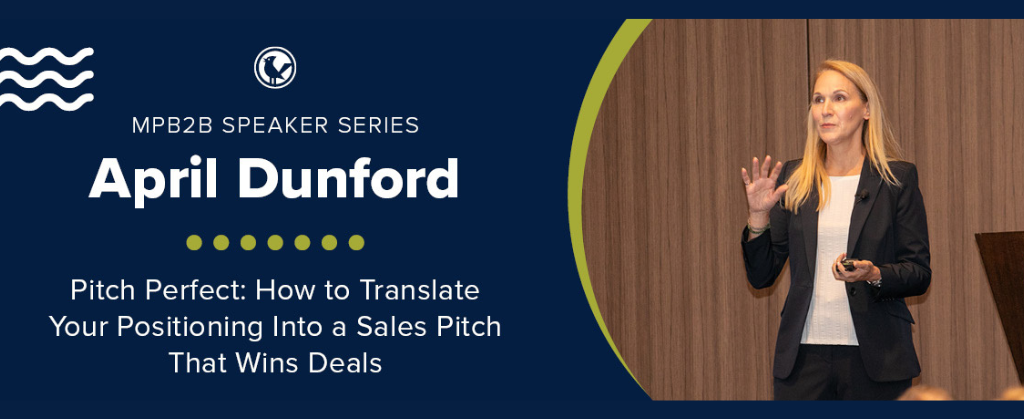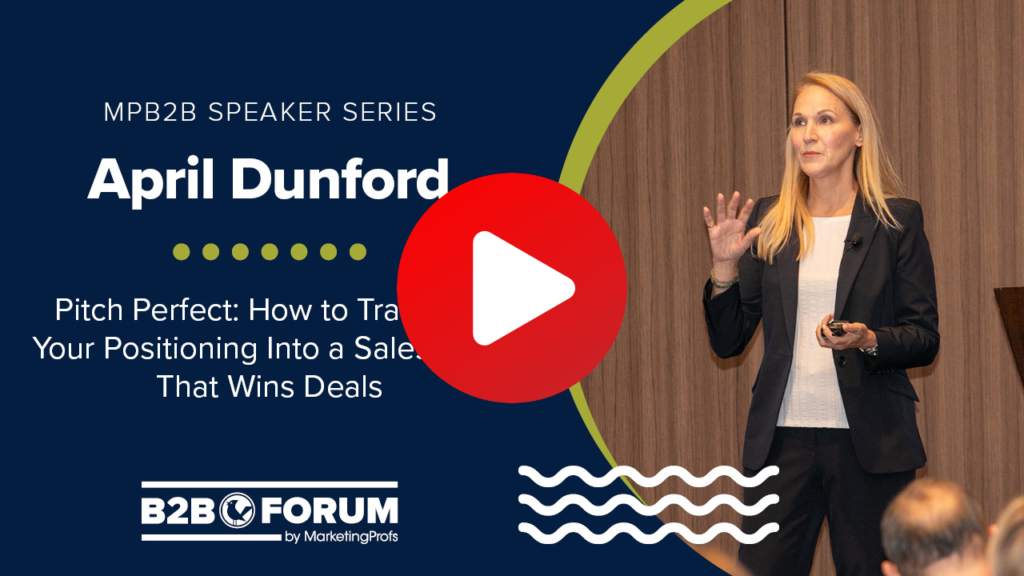
Your hardest competitor to beat in sales isn’t another business at all.
It’s the status quo.
It’s easier for a decision maker to make no purchase at all, than to make a mistake that could cost that person their job, says April Dunford, author of Obviously Awesome: How to Nail Product Positioning so Customers Get It, Buy It, Love It.
So how do you overcome the status quo?
In this clip from B2B Forum 2023, April Dunford reveals why many sales pitches don’t work and how you can transform your offer into value that the customer can understand.
Watch the clip or read the transcript below.
This is just one snippet from more than 45 presentations at B2B Forum 2023. B2B Forum returns in November, 2024, to the Omni Hotel in Boston. Tickets are limited and available now with a discount for early registration. More details here.

Let’s think about how a typical B2B purchase process goes, especially if we’re talking [about] something mid-market-enterprise and above.
Let’s take something simple like accounting software.

Vice president of finance, going through an audit, wakes up in the morning and says, “you know what I hate? I hate our accounting software. We have outgrown it. It’s terrible. I hate it. We need new accounting software.”
Now, does she go Google and whatever and try to figure out what accounting software to buy?
No. She’s in the middle of an audit. She’s busy. She hasn’t got time for that.
She goes into the office and she looks around and she’s like, “you, Joey. You figure it out. You get out there, you look around at all this accounting software, you figure it out, you come back, make a recommendation to me and tell me what accounting software we should buy.”

How’s Joey feeling?
Oh, he’s pissed, right? He’s pissed. He’s like, “I’m an accounting software user, but I don’t know who the vendors are in accounting software. I don’t know what the state of the art of accounting software is. I don’t know what’s possible and not possible in accounting software.”
So what does he do?
He Googles it… and this is a nightmare.
There’s 9,000 billion accounting software packages, and I’m looking at sites like G2 Crowd. And oh boy, the top right hand quadrant has 15 vendors in there, and I’m looking at ranking sites, I’m looking at quadrants. I’m looking at all this stuff.
Oh my God, it’s overwhelming! And there’s all these features. I don’t know anything about them. I don’t even know what my purchase criteria should be.
So maybe, maybe I’m on your website and I click that button that says, “give me a demo.”

Then what happens? Oh, this is great.
Joey’s sales rep is like, “Joey, fantastic. You sit over here, you sit right here. I’m going to go over here. I’m your sales rep. Welcome to the wind tunnel of features. I’m going to give you the product walkthrough. There’s seven dropdown menus, and I’m going through every single one. Here’s a feature, here’s a feature, here’s a feature, here’s another feature, feature, feature, feature!”
And Joey’s sitting here with this wind and this hair blowing back going, “I don’t know what any of these mean. I don’t know what this stuff is. Do all the packages have the same features or just you? I don’t know what that feature is. Is it important? What is the value of that feature? Do I understand any of this?”
Now, here’s another thing to understand.
How’s Joey feeling right now? He’s pretty stressed out.
You know why?
If he makes a bad decision at this moment, very bad things could happen. Very bad things.

If he recommends something to his boss and his boss thinks it’s stupid, then he looks stupid in front of his boss. That’s not good.
Maybe he recommends something the whole accounting department hates to use, and now he’s the dummy that picked that stupid thing. Everyone in the accounting department hates his guts.
Maybe he picks the wrong accounting software. They’re in the middle of an audit. The audit goes badly or they fail.
You know what happens? Joey might get fired. That’s very bad.
What is the easiest, lowest risk thing for Joey to do in this situation?
Nothing.
Go back to his boss and say, “you know what? The old accounting software was just fine. It’s not perfect, whatever, but hey, we’re busy right now. We’re in the middle of an audit. We’re just going to kick that can down the road until next year.”
And hopefully, when Janet walks in the office and points at somebody, I’m going to duck and somebody else is going to get the job to go pick this stupid thing.
Now, you might not think that happens very often.
In fact, this happens all the time.

So the research on this is absolutely terrifying. So this is a stat that comes from a book called The Jolt Effect, where they analyzed two and a half million sales calls, and they looked at that.
It depends on your industry and how big the purchase price is, but the stats show that 40 to 60% of B2B purchase processes end in no decision.
And then what’s really interesting is, if you scratch down on that data, it doesn’t end in no decision because people have decided they love the status quo.
“We looked at our options and said, no, we’re just going to stick with the thing because it’s better.”
No. It ends in no decision because customers can’t figure out how to confidently make a decision that isn’t going to get them in trouble, and therefore they just don’t do anything.
So I was working with a company two weeks ago when the CEO saw this stat. He said, “that stat’s wrong.”
And I said, “oh, really? You think it’s lower than that?”
And he goes, “way higher. We’re 80%.”
Terrifying.

So this comes from a great study of B2B software buyers, and they asked them, “what do you actually want in a sales conversation?” Fancy asking that, right? “So what do you wish we were doing in there?”
Top two answers.
The first one is, “I want perspectives on the market. That’s not you. That’s you in the midst of everybody else.”
The second thing is, customers want help navigating alternatives.
That’s what Joey’s doing in there. He’s talking to you, but he’s talking to everybody else on his shortlist too.
So what he really wants is the answer to the question, “why pick me over the other guys?”
And 99 times out of a hundred, we are not answering that question in our sales pitch, which is bonkers.

So how can we actually build a better sales pitch or a sales pitch that is designed to answer that question? Can we do it well, if we’re trying to build a sales pitch where the goal of the sales pitch is to answer this question, why pick us over the alternatives?
The answer to that question is in our positioning.
Our positioning defines how we are the best in the world at delivering something, some value, that a well-defined set of customers cares a lot about.

That’s literally what our positioning is. If we did a better job of taking our positioning and translating it into a sales pitch, we would do a good job of answering this question. We know the answer to this question.
Now, how do we actually do that?
So if any of you are familiar with me, or any of my work, positioning is kind of my jam. And so I have a methodology for doing positioning, but you may have this already.
So the first thing is, what are the alternatives to what we do? And so we can group those alternatives into approaches.
So we might say, well, one approach is to just do it with a spreadsheet or do it manually. Another approach is, well, we might do it this way and there might be three or four competitors in your landscape that do it in a particular way, and then there might be another approach to it.
So we need to figure that out. So first we got to put the stake in the ground.

Who do we got to beat in order to win a deal? That includes the status quo.
Then we can take the next step, what do we got that the other guys don’t have? Capabilities wise.
So feature-functions of the product, but also capabilities of the company.
Maybe we have professional services and they don’t. Maybe we have a different pricing structure and they don’t. So we need to list all those things and then we have to translate that to value because customers don’t care about your features.
They care about what the features do for their business.
And when we’re doing that translation of value, what we’re looking for are the themes. So usually what we’ve got is two or three value themes, value buckets, pop out of this.
That’s our differentiated value.
Once we’ve got our arms around that and we have it really tightly defined, now we’ve got strong positioning. We can turn that into a strong sales pitch.
Published 01/03/24
B2B Forum is packed with marketing insights, strategies, and tactics taken from the real world experience of over forty industry experts, packaged into context you can actually put to use.
Join us in Boston for B2B Forum 2024 this coming November 12-14, 2024. Early buyers get B2B Forum tickets at their lowest rate, and discounted hotel rooms are available while they last.